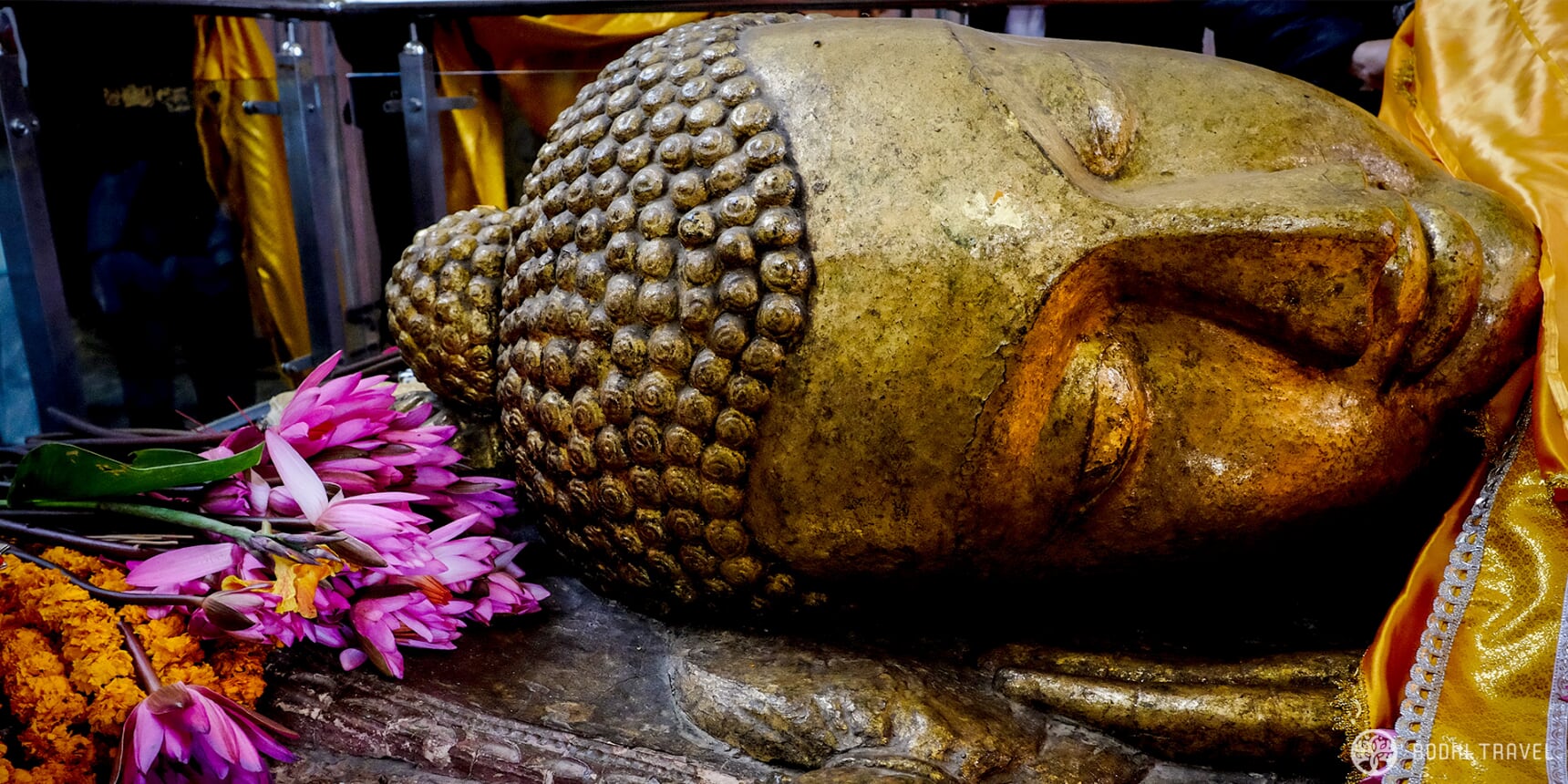
BUDDHIST PILGRIMAGE TOUR IN INDIA
“According to the Mahaparinirvana Sutra, the Buddha instructed Ananda, His personal attendant, that Buddhists who wishes to commemorate and remember the Buddha can visit four places related to His life. Lumbini – where He was borned; Bodh Gaya – where He attained Enlightenment; Sarnath – where He gave His first Sermon; and Kushinagara – where He entered Parinirvana.”
Buddhism originated in India about 2600 years ago. After the Buddha gained Enlightenment at the age of 35, He spent 45 years sharing His Teachings throughout North India. During His eighty years alive (and especially after He gained Enlightenment), many locations became important Buddhist sites, and today Buddhist pilgrimage destinations.
Immediately after the passing of the Buddha, His foremost disciples convened the First Buddhist Council to record and codify His Teachings. The second Buddhist Council was held 100 years later in the town of Vaishali, another city He frequented. The third Buddhist Council was held in Pataliputra (Patna), during the reign of Emperor Ashoka (268 BC-239 BC). The Fourth Buddhist Council was held at Kashmir, in the time of Emperor Kanishka (127 AD- 141 AD.) He
After more than a thousand years of dominance and influence on the Indian subcontinent, Buddhism eventually died out due to various reasons, including invasions and rise of other faiths. Over time, Buddhism and Buddhist sites eventually became forgotten and abandoned in India.
Revival of the Buddhist faith came with excavations and archaeological digs by British explorers and scientists. Many phenomenal discoveries. In the 19th century, the British archaeologist Sir Alexander Cunningham excavated numerous Buddhist monuments. In 1891, the Sri Lankan scholar Anagarika Dharmapala launched the Mahabodhi Society of India at Bodhgaya. Since then, the Archaeological Survey of India has been responsible for an endless range of excavations. In fact, new excavations are leading to new 'finds' even today. That is why every important Buddhist spot has a site museum, which exhibits a huge range of Buddhist artefacts.
Today, the following are recognised as major destinations for Buddhist pilgrims seeking to follow the footsteps of the Buddha.
-
Lumbini (Nepal) – where the Buddha was born
-
Bodhgaya (Bihar, India) – where the Buddha gained Enlightenment under the Bodhi Tree
-
Sarnath (in Uttar Pradesh, India) – where the Buddha gave the First Sermon
-
Kushinagar (in Uttar Pradesh, India) – where the Buddha entered Parinirvana
-
Rajgir (in Bihar) – site where the Buddha gave many important sermons
-
Nalanda (in Bihar) – location of famous Buddhist university in medieval times
-
Kapilavastu (India/Nepal border) – where the Buddha spent His childhood and married life before renouncing to seek the Truth
-
Vaishali (in Bihar) – where the Buddha gave His last sermon
-
Sravasti (in Uttar Pradesh) – where the Buddha spent most of His life during rainy seasons at the Jetavan monastery (built by Anathapindika)

HISTORY OF EVERY LOCATIONS
Lumbini | Bodhgaya | Sarnath | Kushinagar | Rajgir | Nalanda | Vaishali | SravastiLumbini
Lumbini is famous throughout the world for being the birthplace of one of the most influential thinkers and teachers in the history of mankind – the Buddha. A major destination for Buddhist pilgrims, Lumbini is also a place for meditation, renewal and aspiration by visitors.
The outstanding universal value of Lumbini was recognised in 1997 when the place was inscribed in the UNESCO World Heritage List. Being listed as a World Heritage Site reinforces the Nepalese government’s commitment to the cultural and spiritual preservation of Lumbini with continued archaeological research, conservation work, and sustainable site management.
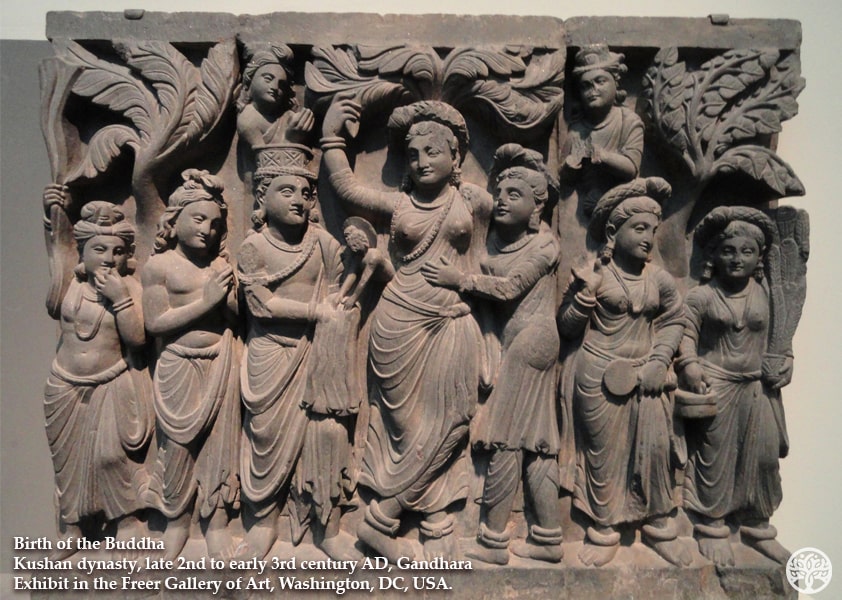
The Buddha was born as Prince Sidhhartha, heir to King Suddhodhana and Queen Maya of the Shakya clan. According to Buddhist traditions, more than 2500 years ago, Queen Maya had a dream of a white elephant entering a womb – a sure sign of an auspicious pregnancy. She was soon pregnant and after months, she was due to give birth. As per the customs of that time, she had to return to her matrimonial home to give birth. Along the way, she stopped at Lumbini where she gave birth to the Prince while holding on to a Sal tree branch.
The authenticity of Lumbini’s status as the birthplace of the Buddha is borne by various artefacts and monuments, some going back thousands of years. There is the Asoka Pillar and remains of viharas, stupas and brick structures dating back from 3rd century B.C.
in its original form, Lumbini was a simple village surrounded by dense forest. With the birth of Prince Siddhartha, the Enlightenment of the Buddha and His eventual Parinirvana, Lumbini acquired a sacred status with the resulting construction of temples and stupas around the area. Over time, the temples and stupas are abandoned but today the remains of these monuments remain.
Lumbini is located 25km away from Tilaurakot (to the west) – site of the ancient palace of the Sakya Kingdom. Towards the east, 55km away is Devdaha, site of the Koliya Kingdom, birthplace of Queen Maya.
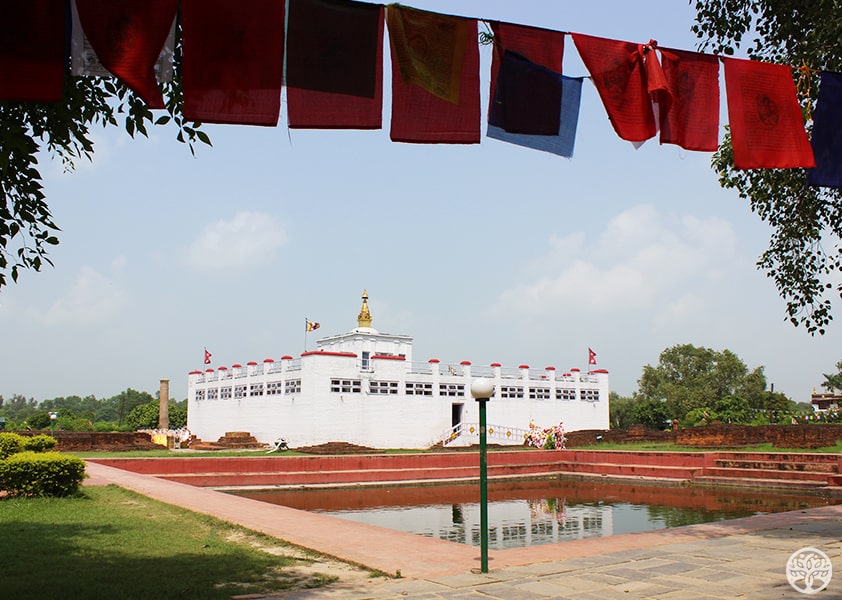
Today Lumbini is designed under a masterplan to be protected by a three by one mile area with a circular levee and monastic zones to ensure emulation of how Lumbini looked in the past. Inside the protected area is the Maya Devi Complex - a landscaped garden consisting of the Maya Devi temple, Puskarini (Holy Pond where the baby prince had his first bath), an Ashoka pillar and a Bodhi tree.
The major structure inside the area is the Maha Devi Temple, built to protect the archaeological remains of an ancient temple built to mark the birthplace of the Prince Siddhartha. Located within the area in an outer three by three mile zone are Buddhist temples from different countries - Chinese, Korean, Japanese, Thai, Cambodian etc.
Bodhgaya
"When the great earth is shaken, this place alone is unmoved!" said the Chinese traveller Xuan Zang, when he visited the serene and sacred spot of Bodh Gaya.
The holiest of holy places for the Buddhists, Bodh Gaya is the place where we can find the site of the Bodhi Tree, under which the Shakyamuni sat and attained Enlightenment. It is also the site of the Mahabodhi Mahavihara, a reconstruction of an ancient shrine built to commemorate the seat of Enlightenment.
Today the Mahabodhi Mahavihara is managed by the BodhGaya Temple Management Committee – a not-for-profit organisation. In 2002, the Mahabodhi Temple Complex at Bodh Gaya was officially inscribed as a UNESCO World Heritage Site.
The Mahabodhi Mahavihara is one of the oldest living shrines in the world. Its message and beauty have spread all over Earth. The current structure was restored more than a hundred years ago following excavations by British researchers and campaigns by Buddhists.
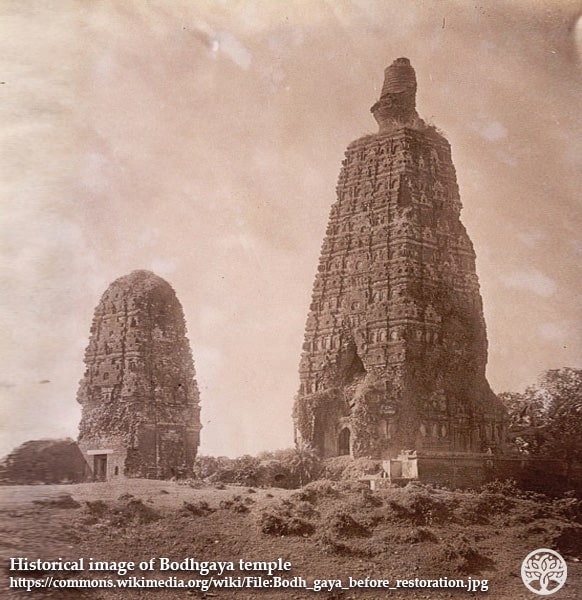
First built by the Emperor Asoka in the 3rd century BC, the present temple dates from the 5th century or 6th century AD. It is one of the earliest Buddhist temples built entirely in brick, still standing in India. It is 170 feet tall and is noted for its stunning architecture and superb workmanship. There are stone sculpted balustrades, grand turrets, minute inscriptions, intricate images of Buddha.
A grandly carved torana or stairway leads from the main entrance, to the Mahabodhi Temple. On the left of the Temple entrance, there is a small shrine, which has the Buddhapuda or Buddha's footprints in black stone.
Located inside the Mahavihara is a small room with a golden statue of the Shakyamuni Buddha. Devotees will quietly queue up to make their way inside the room to pay their respects, conduct their prostrations and reaffirm their vows before making their way out to the exterior.
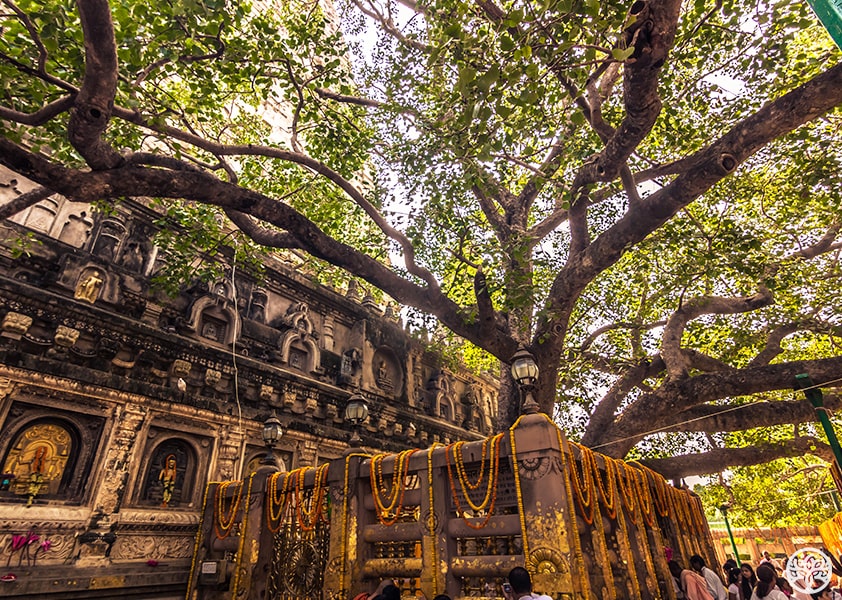
Located at the back of the Mahavihara is the Bodhi Tree, the tree under which the Buddha sat and attained Enlightenment. The Bodhi Tree is the most important attraction in the temple complex. The sacred tree is supposed to have sprung up on the very day that the Buddha was born. It has been transplanted at least five times, at Bodhgaya. The present one is supposed to have come from a sapling brought by Emperor Asoka. It is a lush, all-enveloping tree, which conveys a tremendous sense of peace and serenity, that permeates through the whole temple. The arresting atmospherics of Bodhgaya has been universally commented upon, by all those who have visited it, Buddhists and non-Buddhists.
Under the Bodhi tree, is the Vajrasana or Diamond Throne, a rich, red slab of stone which had been placed by Emperor Ashoka, to denote the exact spot where the Buddha had gained enlightenment. Made of sandstone, the Vajrasana features animal and bird motifs at the side and carved geometrical patterns on the surface. Surrounded by railings, it is not possible to touch the Vajrasana today but one can glimpse at the magnificent keepsake from ancient times.
Surrounding the Mahavihara complex are also markings indicating the presence of the Buddha during the 49 days after His Enlightenment. It was stated that after attaining Enlightenment, the Buddha spent 49 days contemplating on His Enlightenment. He spent these seven weeks at seven locations, which are marked throughout Bodh Gaya.
There's the Animesh Lochan Chaitya, where the Buddha gazed at the Bodhi tree without blinking, the Ratnachakrama or Jewelled path, where lotus flowers bloomed under the Buddha's feet, the Ratnaghar Chaitya, where the rays of five colours emanated from the Buddha's body, and later became the colours connected with the religion (blue, red, yellow, white, orange). There are also the Rajayatna Tree and the Ajapala Nigrodlha Tree, where the Buddha meditated at length.
Then, there's the Muchchalinda pond, where he meditated during the rains, arid was protected by the hood of the Nagraj serpent especially when Mara, the demon, created thunder, lightning, storms, to distract him, and also sent his three daughters to tempt him. In fact, a stone-image of a hooded Naga-serpent protecting the Buddha, in the lake, adds an uncanny air of realism to the scenario.
Over the one and a half millennia after the Buddha’s Enlightenment, Buddhism enjoyed royal patronage from Mauryan, Kushan and, later, Pala empires. Bodh Gaya and Nalanda developed into places of learning and attracted learners worldwide. Today Bodh Gaya is back to its preeminent spot as one of the four holy sites for all Buddhist pilgrims.
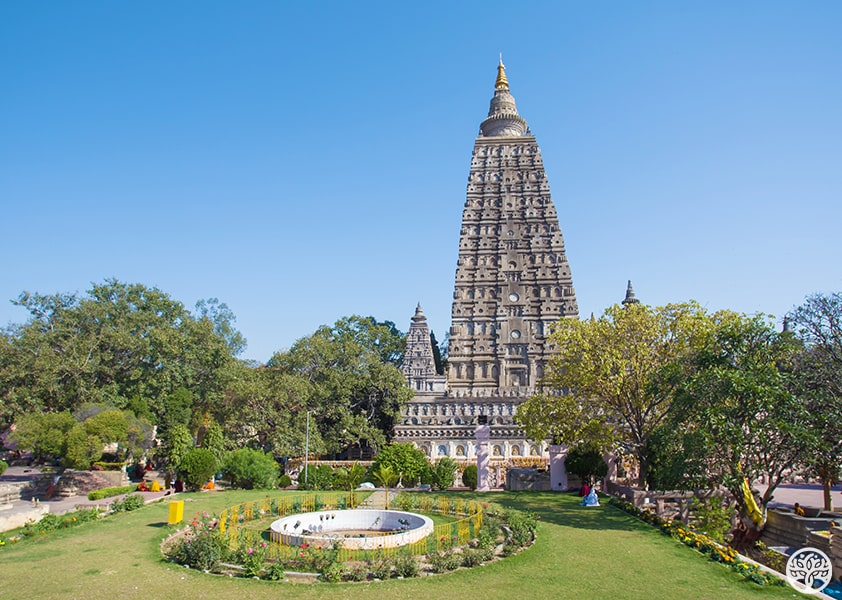
The stirring structure of the Mahabodhi Mahavihara is believed to be inspiration for important Buddhist buildings throughout Asia – the Chiang Mai Temple in Thailand, The Pagan Pagoda in Myanmar, the Mahabuddha Temple in Nepal and the Wuta Si Pagoda in China.
Outside the temple complex, there are several beautiful temples and monasteries built by other Buddhist nations-Bhutan, China, Japan, Myanmar, Nepal, Sikkim, Sri Lanka, Taiwan, Thailand, Tibet and Vietnam. These buildings are unique because they reflect the architectural style of their respective countries. The statue of Buddha in the Chinese temple is 200 years old and was brought from China. Japan's Nippon temple is shaped like a pagoda, as also the Myanmar temple, which resembles its famous Bagan temple. The Thai temple has golden tiles, and a massive bronze statue of Buddha.
The Bodhgaya Archaeological Museum is a treasure-trove of Buddhist sculptures, from the 1st century to the 11th century. A colossal image of a standing Buddha in the Abhaya Mudra pose, is particularly outstanding.
Many festivals are celebrated in Bodhgaya, the most important being 'Buddha Poornima'. This is the important day when the Buddha was born, gained 'Enlightenment’ and went through `Mahaparinirvana'.
In the evening, its magnificent to simply sit in front of the Bodhi tree, and sink into its reverential beauty. The shining moonlight, soothing chants, serene peace add to the magic atmospherics. This is one time and place where any individual can break away from the teeming world, and revel in the aura of isolation.
Sarnath
Sarnath is an important site for the Buddhist pilgrims and one of the four holy sites for Buddhists following the Life of the Budda.
After the Buddha achieved Enlightenment at Bodh Gaya, He scoured the surroundings for potential disciples who could understand His Teachings. He remembered His five followers who left the Shakya Kingdom and discovered that they were residing at a deer park near Sarnath.
The Buddha went to Sarnath where He delivered His first sermon to the five disciples. They quickly understood His Teaching and thus the Sangha in Buddhism was established, completing the Triple Gem of the Buddha, Dharma and Sangha.
The Buddha’s first sermon is known as the Dhammacakkappavattana Sutta (Pali) or The Setting in Motion of the Wheel of the Dharma Sutta. During this sermon, the Buddha taught the Four Noble Truths.
The Buddhist Sangha grew to sixty monks, whom the Buddha sent to different parts of the kingdom to spread his Dharma. The Buddha also travelled widely, but he often returned to Sarnath, to meditate and preach, especially during the rainy season.
The Deer Park, where the Buddha gave his first sermon, is the most attractive part of Sarnath, with its emerald-green lawns, small hill-tops, surrounded by the majestic ruins of many stupas and chaityas.
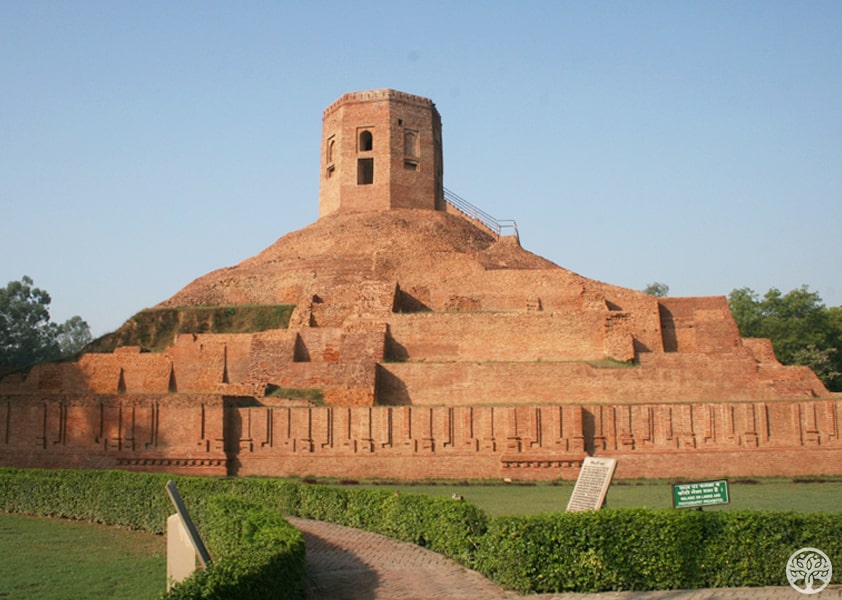
The Chaukhandi Stupa, on a high mound, is one of the first sights in Sarnath. It has the ruins of a Buddhist monastery of the 5th century AD, supposedly to mark the spot where Buddha first met his five disciples, when he reached Sarnath. An interesting feature of this stupa is an octagonal tower in the Islamic style. This was supposed to have been added, much later, when the Mughal Emperor Akbar, who was open-minded to all religions, visited Sarnath, in 1588.
The Sangha grew to sixty monks, whom the Buddha sent to different parts of the kingdom to spread His Dharma. The Buddha also travelled widely, but He often returned to Sarnath, to meditate and preach, especially during the rainy season. The Deer Park, where the Buddha gave his first sermon, is considered by some as the most attractive part of Sarnath, with its emerald-green lawns, small hill-tops, surrounded by the majestic ruins of many stupas and chaityas.
After the Buddha entered Parinirvana, Sarnath continued to grow as an important Buddhist centre.
It was Emperor Ashoka, again, who resurrected this sacred Buddhist town, when he visited it and erected his famous Ashoka Pillar. The pillar was once 15 metres tall, and although it is now in ruins, is still impressive looking. The four lion-heads on top of the pillar, facing four different directions and called the Lion Capital, were destroyed, but were later excavated, and are now on display in the Sarnath Museum. The four-lion head is now the important National Emblem of lndia.
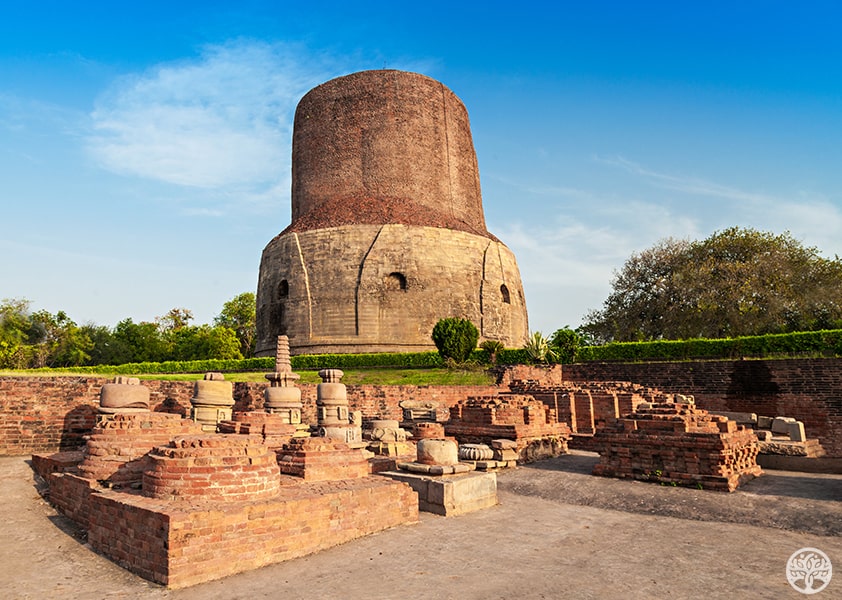
Ashoka also constructed the biggest and most striking stupa, the Dhamekh Stupa. According to an inscription marked 1026 AD, the Dhamekh Stupa stands on the site of the old Dhamra Chakra Stupa, a stupa built to mark the spot where the Buddha gave His first sermon. It is a solid cylindrical tower, 128 feet high and 93 feet in diameter. The borders have delicately carved geometrical and floral patterns, and the figures of humans and birds, which are all very soothing to the eye. The name Dhamekh has been connected to Buddha's `Dharma'. Most Buddhists who visit Sarnath, circumambulate around this stupa, chanting mantras as they reflect on the Teachings of the Buddha.
The Chaukhandi Stupa, on a high mound, is one of the first sights in Sarnath. It has the ruins of a Buddhist monastery of the 5th century AD, supposedly to mark the spot where Buddha first met his five disciples, when he reached Sarnath. An interesting feature of this stupa is an octagonal tower in the Islamic style. This was supposed to have been added, much later, when the Mughal Emperor Akbar, who was open-minded to all religions, visited Sarnath, in 1588.
Among the other interesting sights in Sarnath, is the Mulgandhakuti Vihara, where the Buddha meditated, whenever he visited Sarnath, during the monsoons. It has now been converted into a temple, with attractive fresco paintings by a Japanese artist. The lush Bodhi tree outside, is an important and inspiring part of the temple.
The Sarnath Archaeological Museum is the oldest site-museum of the Archaeological Survey of India. It’s designed like a Buddhist vihara or sanghram, with the central hall like a shrine and the galleries like monastic cells. The five galleries and two verandahs have a wealth of Buddhist sculptures, inscriptions, manuscripts from the third century B.C. to the twelfth century A.D. The paintings offer ample proof of the great Sarnath School of Art. There is an image of a serene Buddha with half-shut eyes and smiling lips.
In later centuries during the Kushan and Gupta periods, Sarnath developed to become an important centre of Buddhist scholars and art. Over time, Buddhism disappeared from India and Sarnath entered into obscurity until the arrival of the British archaeologists. During the 1800s and early 1900s, they made numerous discoveries related to Sarnath’s glorious past and these artefacts (one major piece is the Lion Capital of the Asokan Pillar) are now displayed at the Archaeological Museum of Sarnath.
Like Bodhgaya, the town of Sarnath is also studded with monasteries from many Buddhist countries - Thailand, China, Japan, Burma, Korea, Tibet. The Central Institute for Higher Buddhist Studies is also an important building.
Kushinagar
The last of the four holy Buddhist sites is Kushinagar. Located at Gorakhpur, in the state of Uttar Pradesh, the Buddha was said to have laid between two sala trees at Kushinagar while resting before entering Parinirvana. When the Buddha breathed his last, His last words were “Subject to change are all conditioned things. Strive on with diligence!”
Following His departure, His body was cremated and His mortal remains were collected in eight urns and distributed to various stupas in the region. It was said that hundreds of years later, the remains were gathered by Emperor Asoka who built 84,000 stupas to enshrine the relics.
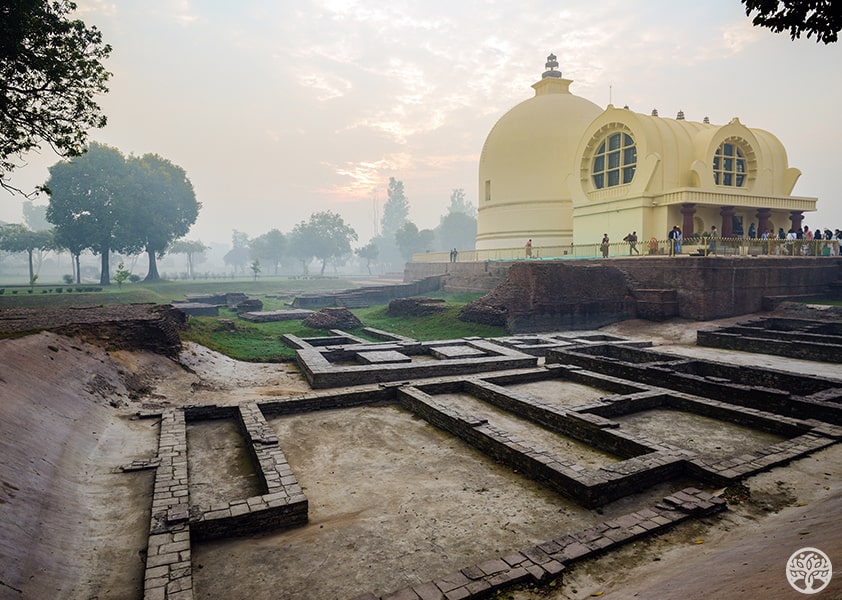
The Mahaparinirvana Temple is the most important monument located at Kushinagara. With a stunning, six-metre long image of the Buddha, in reclining posture, the temple had invoked awe and tears to believers as they reflect on the Buddha's last moments. Originally made of black stone, it looks golden due to the numerous gold leaves placed on it by the Buddhist pilgrims. With a tremendous aura surrounding the statue, devotees were often moved to kneel, pray, meditate when visiting the Temple.
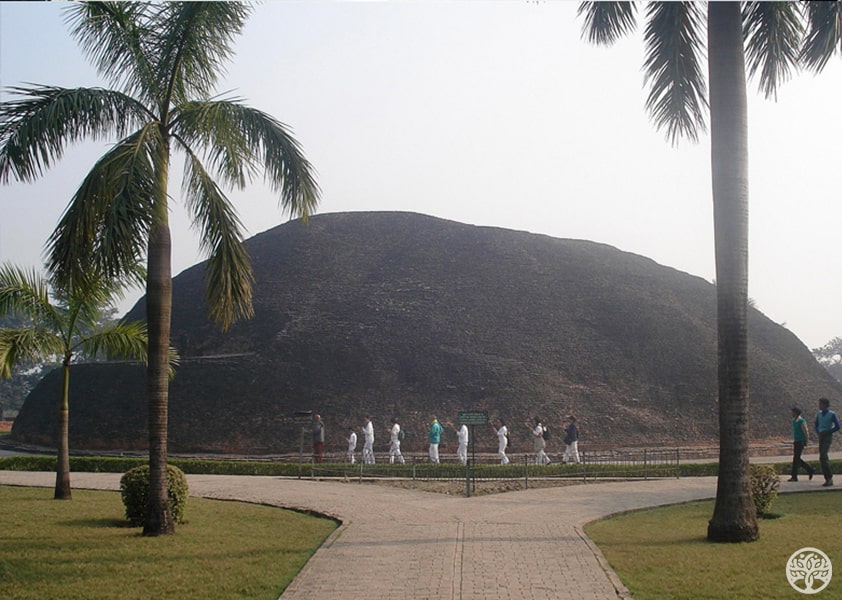
The Ramabhar Stupa is 49 feet long, and is now, a large brick mound. According to traditions, this is where the Buddha was cremated before His remains were encased in eight urns and distributed. Circumambulation by devotees can be seen with them walking clockwise with their right arms closer to the Stupa.
Outside the Mahaparinirvana temple, is the small Mathakuar Shrine, with a riveting black stone image of Buddha in the Bhumi Sparsha pose.
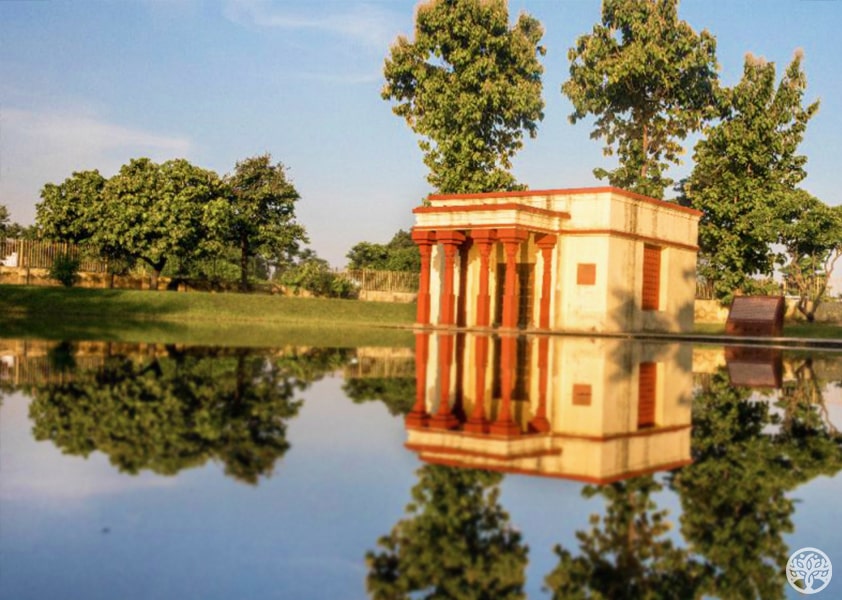
One also sees the Hiranyavati river, and the beautiful ghats, all of which evoke an air of peace and tranquillity. Like Bodhagaya, Kushinagar has tremendous tranquility and offers plenty of space for prayers and meditation. The regular chanting, from early morning to night, add to the incredibly soothing spirit of the last abode of the Buddha.
Like in the other sacred Buddhist places, Kushinagar has beautiful monasteries from other Buddhist countries - the Wat Thai temple, Chinese Temple, International Buddhist Trust and the lovely Meditation Park.
The new Kushinagar Museum is well worth a visit too.
Rajgir
This picturesque town with its hills, gardens, caves, is 80 kms from Bodhgaya and 100 kms from Bihar's capital city of Patna.
Formerly known as Rajagaha, Rajgir was the first capital of Magadha, ruled by King Bimbisara (5th — 6th BC) who was one of the most prominent supporters of the Buddha. Buddha used this city as his monsoon retreat for 12 years, and preached his Dharma, which was recorded in writing for the first time here, by his disciples, as the Vinaya Pitaka' and the 'Sutra Pitaka'.
Rajgir has a large range of exciting Buddha-sites. In fact, the first sight is of grand, antique walls, which were once 40 kms long, and which magnificently encircle the whole city.
In Rajgir, the Buddha preached His sermons from the striking — looking Gridhakuta Hill or Vulture Peak, which had a unique rock formation, like a vulture's beak. It was here that the Buddha preached the Lotus Sutra, which promised salvation for all human beings, and the Prajnaparamita Sutra, described as the 'Perfection of Wisdom' Sutra.
"The mantra of the perfection of wisdom is a mantra of great knowledge. It is an unsurpassable mantra; it is a mantra that totally pacifies all sufferings".
When King Binnbisara was imprisoned by his son Ajatashatru, he watched the Buddha on the hill, from his prison window, and tried to be at peace. The "Binnbisrara Jail" has been excavated in Rajgir, as also the Ajatashatru Fort, where his son Ajatashatru repented, after killing his father, converted to a Buddhist, and placed a statue of Buddha in the `Parinirvana' pose.
When one comes down from the Gridhakuta Hill, one spots the Mardakukshi Vihara, where the Buddha was hurt by a rock hurled by his cousin Devadutta, who wished to kill him.
Close to that, is the Jivakamravana Vihara, which was a mango grove presented to the Buddha by Jivaka, the royal physician who took care of him, when he was hurt by Devadutta.
The Venuvana Vihara or the Monastery of the Bamboo Grove was Bimbisara's first offering to the Buddha. Close by, is the Karanda Tank, where the Buddha bathed.
There are also the grand Pippala Caves and the seven Satapami Caves, where the first Buddhist Council was said to have been held, after the Buddha's Mahaparinirvana.
The town fell into oblivion, when Ajatashatru’s son Udayin shifted the capital to Pataliputra (today known as Patna). It is due to the numerous excavations that took place later, that we are able to witness the importance of this city, as one of the important sites on the Buddha Trail.
Nalanda
The world-renowned university-town was the first residential educational institution in the world, and had as many as 9 million books, 10,000 students and 2000 teachers during its heyday.
It was a supreme centre of learning, between the 5th and the 12th century. Now a World Heritage Site, Nalanda is spread over an area of 14 hectares, and the excavations reveal the extensive remains of 11 monasteries and five temples, with verandahs, quadrangular courts, a shrine to house a large image of Buddha, and niches in the walls studded with small, exquisite Buddha images.
The Chinese traveller Xuan Zang and his disciple Hui Li, both studied at this great institution in the 6th and 7th century and left behind detailed descriptions. They mentioned that admission was very tough, and only two out of every ten eminent scholars were selected. These scholars came from many countries like Java, Korea, China, Japan and Sri Lanka.
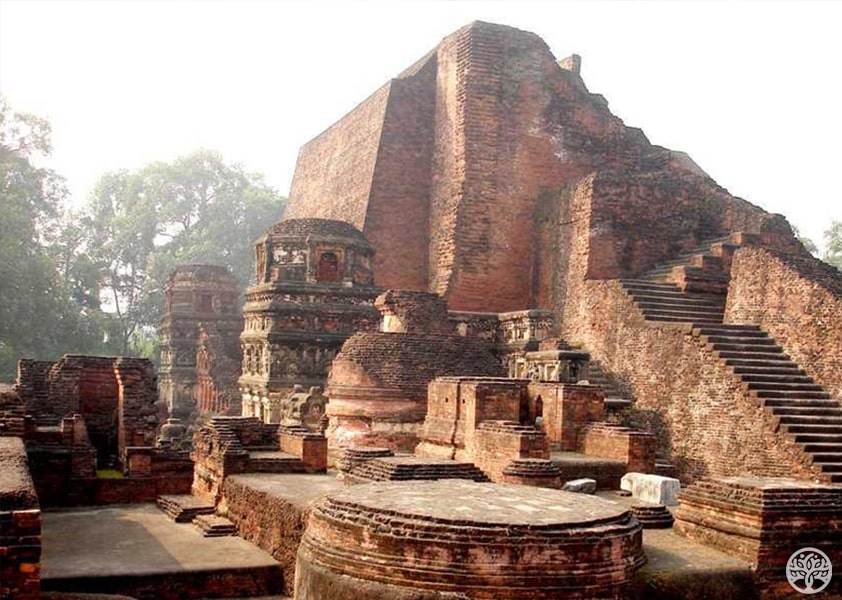
The Nalanda Varsity was noted for its vibrant and modernistic system of education, including the art of debate and public speaking. Many reputed Indian scholars emanated from this varsity, like Nagarjuna, Aryabhatta. They later went to Tibet and other places, spreading the teachings of the Buddha. Emissaries came from around the world, with big donations for the varsity.
Buddha was known to have visited Nalanda when it was a small village. One of Buddha's most learned disciples, Sariputra, who had an important place in the Sangha, attained Nirvana here.
The Sariputra Stupa was built by Empereor Ashoka, in memory of Satiputra. It is easily the most impressive structure, with its grand shrine chamber that once housed a huge image of the Buddha, the impressive corner towers, and the beauteous stucco images of Buddha and the Bodhisattvas, on the walls.
The famed Chinese traveller Fa Xian mentioned this stupa in his writings.
The varsity was destroyed in the 12th century and was resurrected after numerous excavations established in Nalanda, which does important research on Pali and Buddhist studies. The Archaelogical Survey of India also opened a Museum, right across the main entrance of the varsity. It has some exquisite bronzes of the 9th and 10th centuries, as well as many arresting artefacts from the excavations.
As in the other Buddhist sites, there are temples from other Buddhist countries in Nalanda, including Thailand.
Vaishali
Five years after His Enlightenment at Bodhgaya, the Buddha came to Vaishali, famed as one of the first 'republican' states in the world. He was received by the noble Lichchavi community, to whom He preached the Ratna Sutra.
The Kutagarshala Vihar or 'Buddha Stupa 2' was built by the Lichchavis for the Buddha, and still looks impressive, with a large monastery, extensive courtyard and open verandah.
It was in Vaishali, that women were ordained into the Sangha for the first time. These included the Buddha's foster mother Mahaprajapati Gautami, who was one of 500 Sakyan women who came all the way from Kapilavastu to Vaishali, in order to join the Order. The Buddha was hesitant at first, but finally, admitted the women as bhikshunis or nuns.
This town is also noted for the famous courtesan, Amrapali, who joined the Sangha. The neighbouring village of Annvara is said to be the site of Amrapali's mango grove that she donated to the Buddha.
Vaishali is an important town on the Budddhist circuit, because the Buddha preached his last sermon here. He told his favourite disciple Anand, to inform his bhikshus about his imminent end, and then, left for Kushinagar soon after that.
According to Buddhist traditions, Ananda attained Nirvana outside Vaishali.
Emperor Ashoka erected his Asoka Pillar here, and a large brick stupa, to commemorate the sacred spot of the Buddha's last sermon.
Among the important sights here, is the Relic Stupa or `Stupa 1', where the Lichchavis reverentially encased one of the eight portions of Buddha's relics, after His Mahaparinirvana. This is now preserved in the Patna Museum.
All these were excavated in the 19th century by the British archaeologist Sir Alexander Cunningham.
Many of these finds are in the Site Museum which has an excellent collection of artefacts from the third to the sixth century.
Also worth seeing, are the Japanese Temple and the Vishwa Shanti Stupa (World Peace Pagoda), both built by the Japanese.
A hundred years after Buddha's Parinirvana, Vaishali was chosen as the venue for the Second Buddhist Council, where many important decisions were made and many missionaries were despatched around the world, to spread the Dharma.
Sravasti
Sravasti was the capital of the ancient kingdom of Kosala, and the biggest town in the Gangetic plains during the Buddha's time. At Sravasti, the Buddha stayed in the Jetvana Vihara of the lush Jetvana Gardens, which attracted many Buddhist pilgrims today for its beauty and peace. Here again, the supreme serenity inspires travellers to rest and relax, pray and meditate.
The Buddha stayed in Anandakuti and Gandhakuti, whose ruins still remain, and are sacred to the Buddhist pilgrims. The whole Sangha used to congregate in Sravasti, with the Buddha, during the ‘Vassavassa' or 'Rainy retreat' season.
In fact, the Buddha expounded a major part of the ‘Tripitakas' in this city.
The city is studded with many antique stupas, monasteries, and temples. The lush Anand Bodhi tree, planted by Buddha's favourite disciple, Anand, is very attractive. The tree exudes almost as much peace and serenity as the Ananda Bodhi Tree, and is a favourite spot for Buddhist pilgrims to pray and meditate.
It was in Sravasti that the Buddha performed the only miracle of his life, in response to non-believers. He levitated on a thousand-petalled lotus, and a lot of fire and water emanated from his body. This has been beautifully drawn in a panel which caused huge excitement when it was first excavated.
There is also the Angulimala Stupa, built in memory of the killer Angulimala, who was notorious for wearing a necklace of human fingers (of his victims) around his neck. He wanted to kill his own mother, but when he met the Buddha, the latter's serene words changed him, and he became an ardent disciple if the Buddha.
Like the other Buddhist sites, Sravasti has a range of beautiful monasteries built by other Buddhist countries — Thailand, Japan, Myanmar, China, and a lush park by the Japanese.
Includes:
- Journey by exclusive Buddhist Circuit Train
-
Private guided tour
-
Airport pickups & drop-offs
-
Transfers between places (with air-cond)
-
Guides and entrance fees
- Excursions and meals as listed in the itinerary
-
Accommodation in indicated hotels or equivalent
Excludes:
-
All domestic and international flight tickets*
-
Travel insurance*
-
Indian/Nepal Visas*
-
Optional excursions
-
Tips (guides and drivers)
-
Alcoholic drinks
-
Anything not mentioned in the above inclusion.
* Can be arranged through us upon request
Talk to our travel representative for more information now!
< You may read about our Disclaimer, Privacy and Data Protection Policy, Terms & Conditions and FAQs here. >




